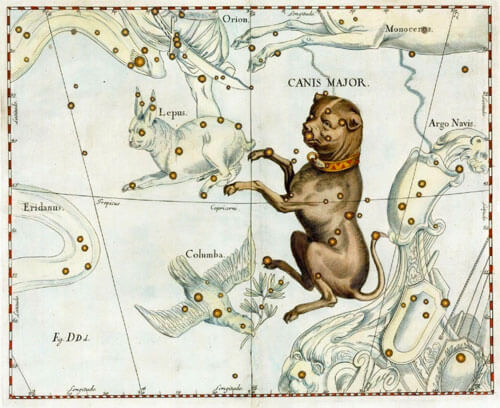The Backyard Astronomer: The Dog Days of Summer
The dog days of summer are upon us. Those steaming days in August when the warmth of the spring and early summer wears out its welcome and the heat can become downright oppressive. The term ÔÇťdog daysÔÇŁ has its roots in astronomy.
The brightest star in the sky is Sirius, the Dog Star. Sirius is so-called the Dog Star because it is also the brightest star in constellation Canis Major, or the Big Dog. The Big Dog can be found nipping at the heels of the Hunter, Orion. Orion is perhaps the most recognizable winter constellation. If Orion and Canis Major are winter constellations, why then, you may ask, are they associated with the sweltering days of summer? The answer lies in the fact that our Sun inhabits the winter stars in the summer which is why we obviously canÔÇÖt see them in the summer. As we spiral through the year, the upcoming seasonÔÇÖs stars start to appear briefly in the sky just before dawn, ahead of the rising Sun. The dawn is like the ÔÇťcoming attractionsÔÇŁ trailers for the next two seasons of stars and constellations.
When a star first becomes visible before dawn in the course of the year, it is called the heliacal rising of that star. Given that Sirius is the brightest star in the sky, the Dog StarÔÇÖs heliacal rising has been carefully noted by faithful sky-watchers throughout history.
It wasnÔÇÖt lost on our ancestors that SiriusÔÇÖ heliacal rising coincided with the scorching days of the waning summer. The ancient Greeks and others believed that the combination of the Sun and SiriusÔÇÖ energy caused the unpleasantly hot weather. The ancient Greeks knew the star as Se├şrios or ÔÇťScorcher.ÔÇŁ
The reappearance of the Dog Star in our morning sky also occurs just as the Nile River regularly floods each year, so SiriusÔÇÖ heliacal rising was a red-letter day on the ancient Egyptian calendar.
While the Dog Star is so bright and one of our nearest neighbors in space at 8.6 light years, there is no meaningful heat added to our summer from its energy. The warmth of summer in the temperate latitudes of our little planet is caused by the tilt of EarthÔÇÖs rotational axis in relation to the plane of our orbit around the Sun. When we reach that time of year when our hemisphere points toward the Sun, the days are longer and hotter.
Sirius is not one star at all, but actually two stars. The majority of stars we can see in the night sky are binary systems of two or more stars. Sirius A is twice as massive as our sun and 25 times more luminous. So, Sirius is much bigger and more luminous than the Sun and very close to us. No wonder the Dog Star blazes so brightly in our winter sky.
Sirius B is a white dwarf star that was once a bright, blue star like Sirius A before blowing up into a red supergiant, consuming most of its atomic fuel and collapsing back into a white dwarf. Very patriotic, Sirius BÔÇöitÔÇÖs been red, white and blue, or blue, red and white in turn.
So, as the sultry dog days wear on this summer, remember the Dog Star for which they are named and look for SiriusÔÇÖ glittering white light low in the southeast sky just before dawn.
Questions, comments or stellar observations for The Backyard Astronomer? Email: backyardastronomer365@gmail.com.











